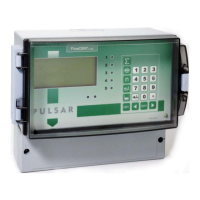Page 75
Alarms
When P210, 220, 230, 240, 250 =1 (Alarm)
The second parameter for each relay determines the function of the alarm.
P211, P221, P231. P241, P251 - Relay Function
This parameter defines what function the alarm will respond to as follows.
Alarm is based on the level in the vessel, and the
type of level alarm (P212, 222, 232, 242, 252) and
two setpoints must be set (P213, 223, 233, 243,
253 & P214, 224, 234, 244, 254). Setpoints are
entered in Display Units or % of span as referenced
to Empty Level
*
.
Alarm is based on the rate of change of level in the
vessel, and the type of rate of change alarm (P212,
222, 232, 242, 252) and two setpoints must be set
(P213, 223, 233, 243, 253 & P214, 224, 234, 244,
254). Setpoints are entered in Display Units per
minute or % of span per minute and a negative
value should be entered for a Rate Alarm on a de-
creasing level, and a positive value for an
increasing level.
Alarm is based on the temperature, and the type of
temperature alarm (P212, 222, 232, 242, 252) and
two setpoints must be set (P213, 223, 233, 243,
253 & P214, 224, 234, 244, 254). The temperature
used depends on the temperature source selected
(P852). Setpoints are entered in
o
C.
Alarm is raised if the Failsafe Timer (P809)
expires. No setpoints are required.
Alarm is raised if the real time clock fails. No
setpoints are required.
Note that the loss of echo and loss of clock will also be shown on the
display as “LOST ECHO” and “LOST CLOCK” respectively.

